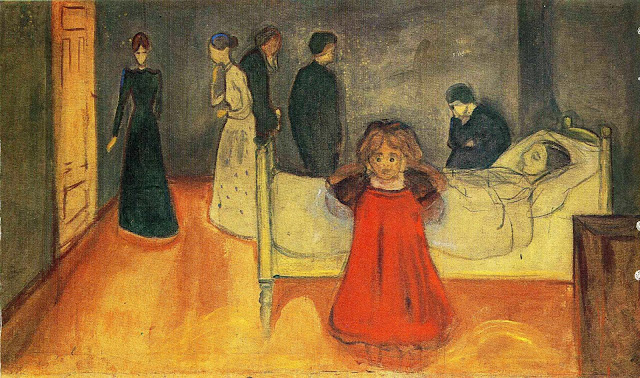The Dead Mother by Edvard Munch (Interpretation and Analysis)
 |
| The Dead Mother Source: Wikimedia Commons |
Edvard Munch epitomizes the stereotype of the tortured artist. The Norwegian painter lived a difficult life that was marred by grief, family troubles, and substance abuse as well as physical and mental health issues.
No piece of art better exemplifies this than Munch’s The Dead Mother. The painting depicts a deathbed scene. In the background, a dead woman with ghostly white skin lies on a bed while adults in dark clothes—presumably mourners or family members—cluster around her. However, the child in the foreground is the most memorable part of the piece. This little girl stands with her hands over her ears and an expression of abject horror on her face. It is clear that the child is in a state of profound shock and grief. The Dead Mother expresses total devastation, verging on madness.Although there are living adults in the room, the child is alone in her pain, standing isolated in the foreground. It is a very sad image, capturing a lonely little girl who has been cast adrift by this tragic loss.
The idea of the dead mother is one that Munch returned to many times throughout his artistic life. He executed several other drawings and paintings of the subject. All contain the same basic elements: a devastated child and the dead mother on a bed. However, in my opinion, this version is the most impactful. The expression of the child in this version is disturbing, and her red dress calls to mind blood, pain, and anger.
 |
| Another Version of the Dead Mother Source: WikiArt |
In fact, the painting is so disconcerting that some viewers actually believe it’s haunted. Proponents of this idea cite the fact that the child’s eyes follow the viewer as they move; however, this is actually caused by a very common painting technique that makes the viewer feel that the subject of the painting is looking at them no matter where they stand.
Most art historians believe that all the dead mother paintings are grounded in Munch’s own experience of loss. His mother died of tuberculosis when he was only five-years-old. Naturally, this was a tragic loss that was devastating to the young boy; however, Munch’s father compounded the pain by expressing his own grief through joyless religiosity that stifled the children and cast a shadow across the household.
Most scholars agree that the child in the foreground represents Munch’s own psychological anguish. It’s notable that this child is alone in the painting; the compositional choice might reflect Munch’s isolated and lonely childhood or the lack of emotional support that he received from his father. The little girl might also be a reference to Munch’s favorite sister, who also died of tuberculosis when the artist was very young. However, while the painting is grounded in personal pain, The Dead Mother also represents the far more universal tragedy of grief and the loss of childhood innocence.
Most art historians believe that all the dead mother paintings are grounded in Munch’s own experience of loss. His mother died of tuberculosis when he was only five-years-old. Naturally, this was a tragic loss that was devastating to the young boy; however, Munch’s father compounded the pain by expressing his own grief through joyless religiosity that stifled the children and cast a shadow across the household.
Most scholars agree that the child in the foreground represents Munch’s own psychological anguish. It’s notable that this child is alone in the painting; the compositional choice might reflect Munch’s isolated and lonely childhood or the lack of emotional support that he received from his father. The little girl might also be a reference to Munch’s favorite sister, who also died of tuberculosis when the artist was very young. However, while the painting is grounded in personal pain, The Dead Mother also represents the far more universal tragedy of grief and the loss of childhood innocence.



Comments
Post a Comment